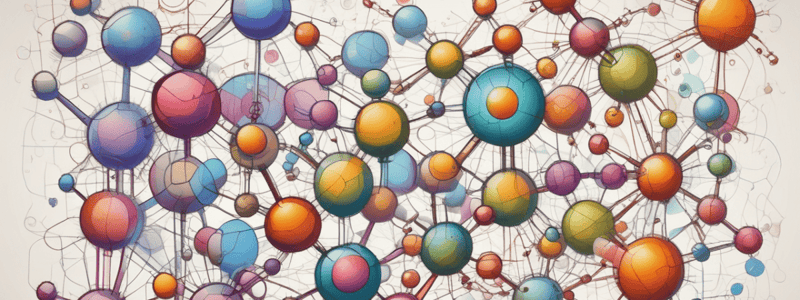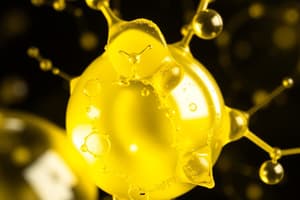Podcast
Questions and Answers
What type of redox reaction involves the transfer of electrons between two substances in the same vessel?
What type of redox reaction involves the transfer of electrons between two substances in the same vessel?
- Indirect redox reaction
- Electrochemical reaction
- Direct redox reaction (correct)
- Intermolecular redox reaction
What is the term for a reaction in which oxidation and reduction take place simultaneously?
What is the term for a reaction in which oxidation and reduction take place simultaneously?
- Redox reaction (correct)
- Electrolysis
- Electrochemical reaction
- Corrosion reaction
What type of compounds contain an element in a lower oxidation state?
What type of compounds contain an element in a lower oxidation state?
- Covalent compounds
- Ionic compounds
- Ous compounds (correct)
- Organic compounds
What is the term for the decrease in oxidation number of an element?
What is the term for the decrease in oxidation number of an element?
What is the strongest reducing agent in solution?
What is the strongest reducing agent in solution?
What is the oxidation state of sulfur in Na2SO3?
What is the oxidation state of sulfur in Na2SO3?
What is the purpose of starch solution in the evolution of iodine from KI solution in the presence of turpentine?
What is the purpose of starch solution in the evolution of iodine from KI solution in the presence of turpentine?
What is the phenomenon where Na2SO3 solution is oxidized by air in the presence of Na3AsO3 solution?
What is the phenomenon where Na2SO3 solution is oxidized by air in the presence of Na3AsO3 solution?
What is the oxidation state of chlorine in KClO3?
What is the oxidation state of chlorine in KClO3?
What happens to the oxidation state of an element when it acts as an oxidizing agent?
What happens to the oxidation state of an element when it acts as an oxidizing agent?
What is the result of the reduction of CuO with carbon?
What is the result of the reduction of CuO with carbon?
What is the oxidation number of iron in the reaction Fe + S → FeS?
What is the oxidation number of iron in the reaction Fe + S → FeS?
What type of reaction involves the addition of hydrogen?
What type of reaction involves the addition of hydrogen?
What is the result of the reaction MnO2 + 4H+ + 4Cl- → MnCl2 + 2H2O + Cl2?
What is the result of the reaction MnO2 + 4H+ + 4Cl- → MnCl2 + 2H2O + Cl2?
What type of agent is fluorine?
What type of agent is fluorine?
What is the oxidation state of sulfur in the reaction H2S + Cl2 → 2HCl + S?
What is the oxidation state of sulfur in the reaction H2S + Cl2 → 2HCl + S?
Which ions are not included in the final balanced ionic equation?
Which ions are not included in the final balanced ionic equation?
What is the term for the reaction in which one substance loses electrons and another substance gains electrons?
What is the term for the reaction in which one substance loses electrons and another substance gains electrons?
What is the purpose of writing ionic equations?
What is the purpose of writing ionic equations?
What is the oxidation state of an element that acts as a reducing agent?
What is the oxidation state of an element that acts as a reducing agent?
What is the oxidation state of iron in the complex [Fe(CN)6]3-?
What is the oxidation state of iron in the complex [Fe(CN)6]3-?
Which of the following reactions is an example of indirect redox reaction?
Which of the following reactions is an example of indirect redox reaction?
What is the first step in the ion-electron method for balancing redox reactions?
What is the first step in the ion-electron method for balancing redox reactions?
What is the change in oxidation number of magnesium in the reaction Mg2+ → Mg0?
What is the change in oxidation number of magnesium in the reaction Mg2+ → Mg0?
What is the role of the activator in autoxidation?
What is the role of the activator in autoxidation?
What is the process by which [Fe(CN)6]3- is reduced to [Fe(CN)6]4-?
What is the process by which [Fe(CN)6]3- is reduced to [Fe(CN)6]4-?
What is the purpose of dividing the half reaction by 2, 3, etc. in the ion-electron method?
What is the purpose of dividing the half reaction by 2, 3, etc. in the ion-electron method?
What is the direction of electron transfer in the reaction [Fe(CN)6]3- + e- → [Fe(CN)6]4-?
What is the direction of electron transfer in the reaction [Fe(CN)6]3- + e- → [Fe(CN)6]4-?
What is the result of the autoxidation of water in the presence of an activator?
What is the result of the autoxidation of water in the presence of an activator?
What is the term for the phenomenon where a substance absorbs oxygen from the air in the presence of water?
What is the term for the phenomenon where a substance absorbs oxygen from the air in the presence of water?
Flashcards are hidden until you start studying



